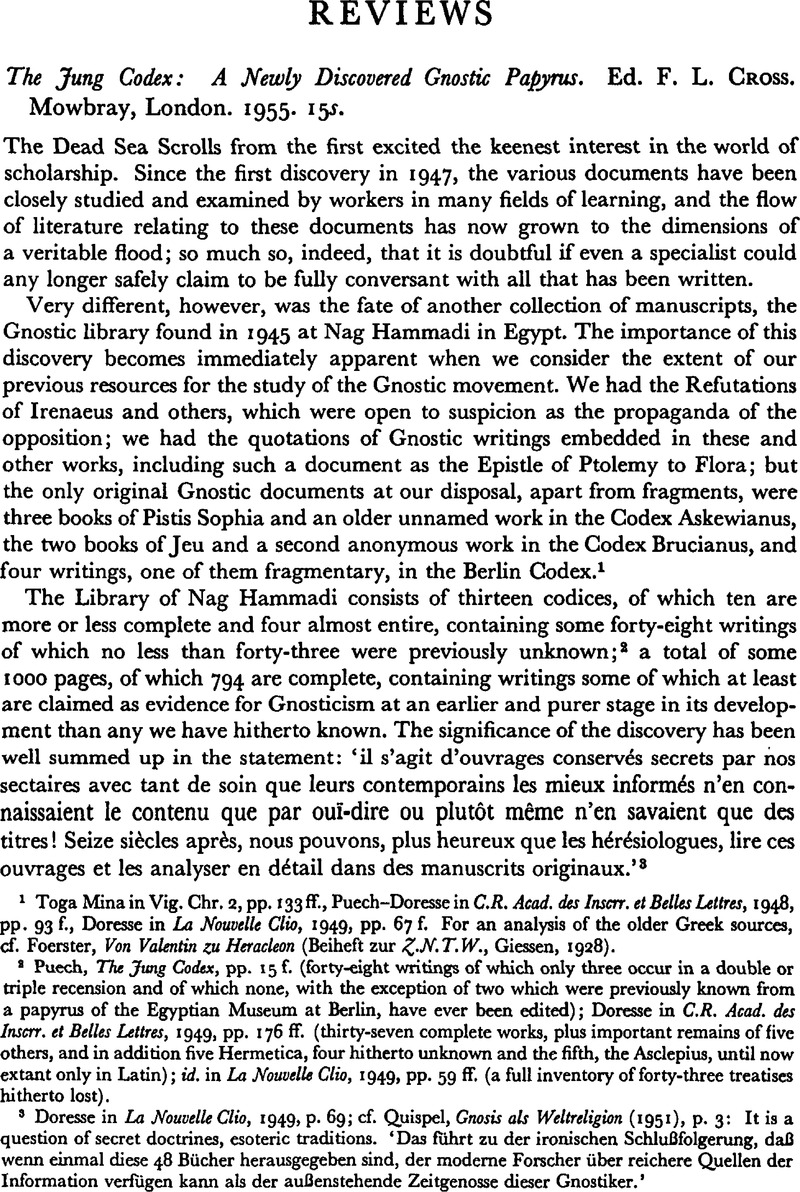No CrossRef data available.
Article contents
The Jung Codex: A Newly Discovered Gnostic Papyrus. Ed. F. L. Cross. Mowbray, London. 1955. 15s.
Published online by Cambridge University Press: 05 February 2009
Abstract

- Type
- Reviews
- Information
- Copyright
- Copyright © Cambridge University Press 1955
References
page 309 note 1 Toga, Mina in Vig. Chr. 2, pp. 133 ff.,Google ScholarPuech-Doresse, Mina in C.R. Acad. des Inscrr. et Belles Lettres, 1948, pp. 93 f.,Google ScholarDoresse, in La Nouvelle Clio, 1949, pp. 67 f.Google Scholar For an analysis of the older Greek sources, cf., Foerster, Von Valentin zu Heracleon (Beiheft zur Z.N.T.W., Giessen, 1928).Google Scholar
page 309 note 2 Puech, , The Jung Codex, pp. 15f.Google Scholar (forty-eight writings of which only three occur in a double or triple recension and of which none, with the exception of two which were previously known from a papyrus of the Egyptian Museum at Berlin, have ever been edited); Doresse, in C.R. Acad. des Inscrr. et Belles Lettres, 1949, pp. 176 ff.Google Scholar (thirty-seven complete works, plus important remains of five others, and in addition five Hermetica, four hitherto unknown and the fifth, the Asclepius, until now extant only in Latin); id. in La Nouvelle Clio, 1949, pp. 59 ff. (a full inventory of forty-three treatises hitherto lost).Google Scholar
page 309 note 3 Doresse, in La Nouvelle Clio, 1949, p. 69;Google Scholarcf., Quispel, Gnosis als Weltreligion (1951), p. 3: It is a question of secret doctrines, esoteric traditions. ‘Das führt zu der ironischen Schlußfolgerung, daß wenn einmal diese 48 Bücher herausgegeben sind, der moderne Forscher über reichere Quellen der Information verfügen kann als der außenstehende Zeitgenosse dieser Gnostiker.’Google Scholar
page 310 note 1 To the notices of the Codex Jung itself in 1953, referred to in the Preface, should perhaps be added the reports by the Manchester Guardian and Glasgow Herald Service, on 20 06 1949,Google Scholar of M. Doresse/s paper presented a few days previously (C.R. Acad. des Inscrr. et Belles Lettres, 1949, pp. 176 ff.),Google Scholar and on 24 June 1949, of the probable purchase of the papyri in question by the Egyptian Government and of the arrangements for publication. The Codex Jung was at this time already on its travels (see The Jung Codex, pp. 40 ff.).Google Scholar
page 310 note 2 Vig. Chr. 2, pp. 137 ff.Google Scholar
page 310 note 3 Schmidt, C.: ‘Irenaeus und seine Queue in Adversus Haereses I 29’ (in Philotesia: Paul Kleinert …dargebracht).Google Scholar The Apocryphon Johannis appears in three different codices of the Nag Hammadi Library, all older than the copy in the Berlin Codex (Puech, , The Jung Codex, p. 22).Google Scholar
page 311 note 1 Cf. Vig. Chr. 8, p. 3, note 3.
page 311 note 2 E.g. on p. 46 a provisional translation of part of the text runs: ‘The Word is like a grain of wheat. If anyone has sown it, he has faith in it, and if it has germinated he loves it, since he sees many grains in place of one and while he works he is being saved, since he can prepare it for a meat and further has enough over in order to sow.’ The French version of the words italicized (in Vig. Chr. 8, p. 13) is: ‘aprs avoir travaillé, il a sa subsistance assurée, s/étant par là procuré sa nourriture et ayant de surcroît de quoi semer.’ So too at the foot of p. 100 (note 2) the Dutch original seems to mean that the Gospel of Truth was the first to come into the reckoning for possible inclusion in the Canon. At the top of p. 116 the words άποχεχρυμμένον and άποχεχρυμμένον have been interchanged.
page 312 note 1 The Jung Codex, p. 21 f.Google Scholar
page 312 note 2 Cf., Quispel, Gnosis als Weltreligion, p. 6.Google Scholar
page 312 note 3 New Testament Studies, I, pp. 137 ff.Google ScholarCf., Schoeps, ‘Das gnostische Judentum in den Dead Sea Scrolls’, in Zeitschrift Religion und Geistesgeschichte, VI (1954), pp. 276 ff.Google Scholar
page 312 note 4 The Jung Codex, p. 8. See further the articles: ‘Christliche Gnosis und jüdische Heterodoxie’, in Evang. Theologie, 1954, and ‘Der gnostische Anthropos und die jüdische Tradition’, in Eranos Jahrbuch, 1954.Google Scholar
page 312 note 5 Gnosis als Weltreligion, p. 5.Google Scholar
page 312 note 6 The Interpretation of the Fourth Gospel, p. 97.Google Scholar
page 312 note 7 Dodd, , loc. cit.Google Scholar




